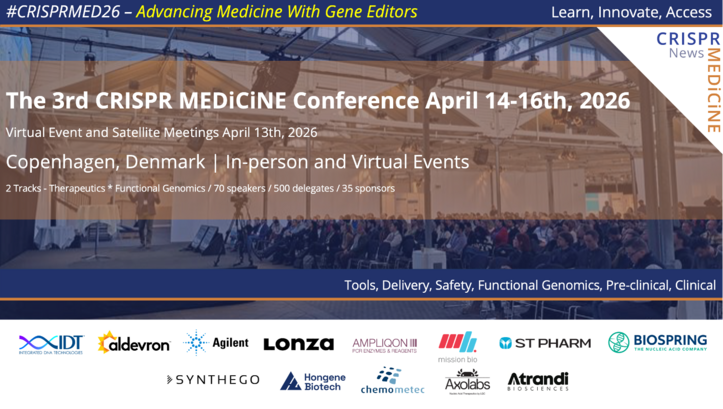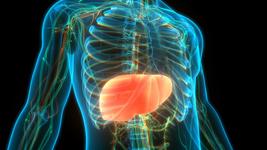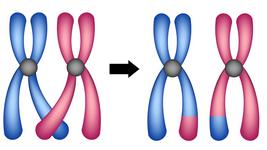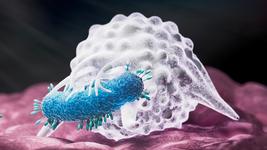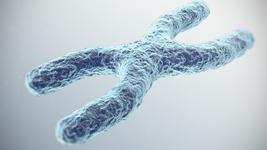CMN Weekly (31 July 2022) - Your Weekly CRISPR Medicine News
By: Karen O'Hanlon Cohrt - Jul. 31, 2022
Do you plan to organise a webinar?
Why not use the CMN platform and get exposed to the global gene editing community.
More details here.
Top picks
- In an article published this week in Nature Chemical Biology, a team of scientists from multiple institutes in the U.S. and China describe a chemically engineered nanosystem encapsulating CRISPR–Cas13d, developed to target lung protease cathepsin L (Ctsl) messenger RNA to block SARS-CoV-2 infection in mice. Coronaviruses are depending upon the CTSL enzyme to gain entry into human cells. The team demonstrated that the novel nanosystem decreases lung Ctsl expression in normal mice efficiently, specifically and safely, and further showed that the approach extends survival of mice lethally infected with SARS-CoV-2, correlating with decreased lung virus burden and attentuation of the inflammatory response. This is the first study to demonstrate that CRISPR can be used against COVID-19, and the findings suggest that CRISPR may be a potential treatment option for SARS-CoV-2 infection.
- Epigenetic editing: a tunable CRISPR alternative. This write-up in BioPharmaDive gives an overview of what epigenetic editing encompasses, and what advantages it could offer over existing editing technologies, before looking at some of the companies working in this space to develop novel epigenome-altering medicines.
Research
- In an article published this week in Nature, researchers in the U.S. report a molecular system for making time-ordered recordings of transcriptional events into living genomes. They refer to their new system as Retro-Cascorder, which they developed via engineered RNA barcodes, based on prokaryotic retrons that are reverse transcribed into DNA and integrated into the genome using the CRISPR–Cas system. In their article, the authors describe how uni-directional integration of barcodes by CRISPR integrases enables the reconstruction of transcriptional event timing based on a physical record through simple, logical rules rather than relying on pre-trained classifiers or post hoc inferential methods.
- In an article published this week in Nature Biomedical Engineering, a team of researchers led by base editing pioneer David Liu report adeno-associated viruses (AAVs) with size-optimised genomes that encode compact adenine base editors (ABEs), which enable efficient base editing in mice at similar or lower doses to dual-AAV systems. The team found that single-AAV-encoded ABEs retro-orbitally injected (i.e. through the sinuses) in mice led to editing efficiencies in liver, heart, and muscle tissues that were up to 2.5-fold those of dual-AAV ABE8e, and to an average 93% knockdown of human PCSK9 and mouse Pcsk9 and Angptl3 in circulation, which coincided with marked reductions of plasma cholesterol and triglycerides. Furthermore, three of the new ABE8e variants collectively offered expanded compatibility with PAM motifs for editing approximately 82% of the adenines in the human genome.
- Researchers in Spain have described a proof-of-concept study to evaluate the synergistic effect of nanoparticles for gene-editing and drug therapy in an in vitro inflammatory model. The team prepared mesoporous silica nanoparticles (MSNs) that were able to co-deliver CRISPR-Cas9 machinery to edit GSDMD, which encodes gasdermin D, a key protein involved in inflammatory cell death, and the anti-inflammatory drug VX-765. Their approach led to sucessful co-delivery of CRISPR-Cas9 and the drug in human cells, GSDMD gene editing, and a combined effect on decreasing the inflammatory response. The authors suggest that their results show the potential of MSNs as a versatile platform by allowing multiple combinations for gene editing and drug therapy and their findings were published recently in Pharmaceutics.
- In an article published this week in Genes, researchers in the UK report their analysis of 247 previously reported pathogenic rhodopsin gene (RHO) variants for suitable PAM sites for currently available base editors. Using several Cas9 variants, the team assessed base editing as a treatment option for RHO-associated autosomal dominant retinitis pigmentosa (adRP). They found that more than half of all analysed variants could theoretically be corrected with base editors, but that PAM sites were available for approx. only one third of them, and unwanted bystander edits were predicted for most of the designed gRNAs. They conclude that base editing provides new avenues to treat RHO-associated adRP in the future, pending further research to develop more precise base editors with expanded PAM compatibilities.
- A research team in China recently reported the co-activation of transforming growth factor β1 (TGF-β1) and vascular endothelial growth factor (VEGF-A) genes in pre-osteoblast MC3T3-E1 cells through the non-viral CRISPR activation (CRISPRa) system to promote osteogenesis. They used a cationic co-polymer carrying nucleus-localising peptides and proton sponge groups dimethyl-histidine to deliver CRISPRa system into MC3T3-E1 cells, and subsequently employed a specially-developed tunable dual-crosslinked hydrogel to implant the CRISPRa-engineered cells into a skull bone defect site in mice to promote bone healing in vivo. The findings were published in Materials Today Bio.
Industry
- Editas Medicine announces clinical achievements in the development of its CRISPR-Cas12a candidate EDIT-301 for the treatment of sickle cell disease (SCD). Earlier this week, the company announced the dosing and confirmed successful neutrophil and platelet engraftment of the first patient in the Phase 1/2 RUBY trial of EDIT-301 for the treatment of severe SCD. This is the first time that Editas' engineered AsCas12a enzyme has been used to edit human cells in a clinical trial. You can read more about EDIT-301 in a previous clinical trial update here.
- Scribe Therapeutics announces the expansion of its San Francisco Bay Area headquarters as well as the appointment of three new vice presidents. Scribe Therapeutics is a molecular engineering company that focuses on creating novel in vivo gene-editing therapies that permanently treat the underlying cause of disease. We spoke with CEO Benjamin Oakes shortly after the company emerged from stealth mode in 2020. You can read that interview here.
- ERS Genomics and Lepton Pharmaceuticals LTD have entered a CRISPR-Cas9 license agreement, according to a joint press release published this week. The non-exclusive licensing agreement grants Lepton access to the ERS CRISPR-Cas9 patent portfolio for certain applications. Lepton Pharmaceutical LTD is an Israelean biotechnology company developing a proprietary, breakthrough technology (Castling Technology) to substantially improve the adaptive cell-mediated immune response mediated by T cells, CAR-T cells, and natural killer cells.
Detection
- In an article published in Expert Review of Molecular Diagnostics, researchers in China describe their efforts to evaluate the diagnostic accuracy of CRISPR-Cas technology for SARS-CoV-2. To this end, they collected CRISPR-Cas-based detection data for SARS-CoV-2 detection independently and assessed it using the Quality Assessment of Diagnostic Accuracy Studies (QUADAS)-2 tool. RT-qPCR was used as a reference standard throughout the study. A bivariate model for pooling was employed to generate estimates of sensitivity and specificity and subgroups analysis was used to explore heterogeneity. The results concluded from all studies showed that CRISPR is a promising and accurate molecular method for detecting SARS-CoV-2, and the authors propose that standard methods including comparable sample material, patient selection, operating procedure and operators should be established.
- Scientists in China have developed a simple, visual, and ultrasensitive CRISPR-Cas12a-based method incorporating recombinase polymerase amplification (RPA) for the detection of Yersinia enterocolitica, a foodborne human pathogen that mainly causes gastroenteritis. They demonstrate rapid detection of a specific attachment invasion locus gene (ail) using their system, and when applied to raw pork that had been artificially infected with Y. enterocolitica, they achieved an estimated detection limit of 1.7 CFU/mL in less than 45 min, which was 100 times lower compared with quantitative PCR. The authors propose that their CRISPR-Cas12a-RPA system has potential for monitoring pathogenic Y. enterocolitica in the chilled meat supply chain, and their findings were recently published in Foods.
Reviews
- Closing the Door with CRISPR: Genome Editing of CCR5 and CXCR4 as a Potential Curative Solution for HIV. This review summarises the current literature regarding CRISPR-mediated genome editing to render cells resistant to HIV (re)-infection by knocking out the co-receptors CCR5 and CXCR4, and provides an independant outlook regarding future research directions.
- Gene Editing and Rett Syndrome: Does It Make the Cut? Rett syndrome (RTT) is a rare and incurable neurogenetic disorder that arises as a result of pathogenic variants of the Methyl CpG binding protein 2 (MECP2) gene. This review examines the literature on the currently available gene-editing technologies and discuss their limitations and applicability to the treatment of RTT.
- CRISPR/Cas9 system in breast cancer therapy: advancement, limitations and future scope. This review highlights the role of CRISPR-Cas9 gene editing as a targeted therapeutic approach to tackle drug resistance and improve immunotherapy for breast cancer.
Conferences
CRISPR and Beyond: Perturbations at Scale to Understand Genomes. This conference will explore methods to modulate the genome at scale, and will be held from 28th–30th September 2022 at Wellcome Genome Campus, UK and virtually. See here for more information and link to registration.
News from CRISPR Medicine News
- In a recent proof-of-concept study, researchers in Austria showed that correcting pathogenic frameshift mutations in the COL17A1 gene using Cas9 nickase restores COL17A1 expression and function in human keratinocytes, and may be an efficient and safe method for the treatment of junctional epidermolysis bullosa. For this week's feature, we spoke with first author of that study Dr. Johannes Bischof, who is postdoctoral researcher at the Department of Dermatology and Allergology, University Hospital of the Paracelsus Medical University Salzburg, Austria. Read what he had to say here.
- After a short holiday break, CRISPR AgroBio News (CARBON) is back on air again with a new edition of the CARBON Newsletter, where you can read about a new system for multiplexed virus detection in plants with mixed infections, and much more. Read the latest CARBON Newsletter here. Sign up to receive the CARBON Newsletter directly into your inbox here.
To get more of the CRISPR Medicine News delivered to your inbox, sign up to the free weekly CMN Newsletter here.
Tags
CLINICAL TRIALS
IND Enabling
Phase I
Phase II
Phase III
Gastric Cancer and Colorectal Cancer, CRC, (NCT07166263)
Sponsors:
Base Therapeutics (Shanghai) Co., Ltd.
Sponsors:
Base Therapeutics (Shanghai) Co., Ltd.
IND Enabling
Phase I
Phase II
Phase III
Relapsed or Refractory Acute Myeloid Leukemia, AML, (NCT06541444)
Sponsors:
Base Therapeutics (Shanghai) Co., Ltd.
Sponsors:
Base Therapeutics (Shanghai) Co., Ltd.
IND Enabling
Phase I
Phase II
Phase III

